#conversionrate
Text
Conversion is really important for any type of business you do online.
Guess what?
We have come up with some solid conversion strategies for your eCommerce business.
4 notes
·
View notes
Text
Affiliate Marketing: Definition, Examples, and Getting Started

What Does Affiliate Marketing Mean?
Affiliate marketing is a model of advertising in which a company compensates third-party publishers for driving traffic or leads to its products or services. Affiliates are the third-party publishers, and the commission fee motivates them to find ways to promote the company.
Affiliate Marketing Fundamentals
Affiliate marketing has become more popular due to the Internet. Amazon (AMZN) popularized the practice by developing an affiliate marketing program that allows websites and bloggers to link to the Amazon page for a reviewed or discussed product in exchange for advertising fees when a sale is made. Affiliate marketing is essentially a pay-per-performance marketing program in which the selling process is outsourced across a vast network.
Affiliate marketing predates the Internet, but analytics and cookies have made it a billion-dollar industry in the world of digital marketing. A business with an affiliate marketing program can track the links that generate leads and use internal analytics to determine how many of those leads convert into sales.
An affiliate may be hired by an e-commerce merchant seeking to reach a larger audience of internet users and shoppers. An affiliate may own multiple websites or email marketing lists; the greater the number of websites or email lists an affiliate owns, the larger its network. The affiliate is then responsible for communicating and promoting the e-commerce platform’s products to their network. Affiliates accomplish this by displaying banner ads, text ads, posting links on their websites, and sending emails to customers. Advertisements take the form of articles, videos, and images to attract the attention of an audience to a service or product.
When a user clicks on an advertisement or link, they are redirected to the e-commerce site. The e-commerce merchant credits the affiliate’s account with the agreed-upon commission, which could range from 5 to 10 percent of the sale price, if the customer makes a purchase.
Specific Considerations
This model aims to increase sales and create a solution that benefits both the merchant and the affiliate. The system is unique, profitable, and gaining in popularity.
Internet and advancing technologies facilitate the model’s implementation. How companies track and pay commissions on qualified leads has been improved. The ability to better track leads and sales contributes to their ability to improve or reposition their products.
Those interested in affiliate marketing will benefit from gaining an understanding of the process, as well as its benefits and drawbacks. The screening and qualification of partners is advantageous for businesses seeking affiliates. Overall, it is a low-cost, efficient method of advertising products and services, boosting brand recognition, and expanding a consumer base.
Affiliate Marketing Types
There are three primary types of affiliate marketing: unattached, related, and involved.
Independent Affiliate Marketing:
This is a model of advertising in which the affiliate has no affiliation with the product or service being promoted. They have no known relevant skills or expertise and neither serve as an authority on nor make claims regarding its application. This is the easiest type of affiliate marketing. The absence of a connection to the potential customer and product releases the affiliate from the obligation to recommend or provide guidance.
Affiliate Marketing Related
As the term implies, related affiliate marketing entails the promotion of products or services by an affiliate with a connection to the offering. Typically, there is a connection between the affiliate’s specialized market and the product or service. The affiliate has sufficient expertise and influence to generate traffic, and their level of authority makes them a reliable source. However, the affiliate makes no claims regarding the use of the product or service.
Affiliate Marketing Involvement
This type of marketing forges a stronger bond between the affiliate and the product or service being promoted. They have used or are currently using the product and are confident that others can benefit from their positive experiences. Their experiences serve as advertisements, and they are reliable information sources. On the other hand, because they are providing recommendations, any issues with the offering could jeopardize their reputation.
Positives and Negatives of Affiliate Marketing
Affiliate marketing can generate substantial returns for both the advertising agency and the affiliate marketer. The company benefits from the low-cost advertising and innovative marketing efforts of its affiliates, while the affiliate earns additional income and bonuses. Affiliate marketing has a high return on investment, as the company only pays for sales-generating traffic. Advertising expenses, if any, are borne by the affiliate.
The advertising agency determines the affiliate marketing program’s parameters. Initially, banner advertisements were paid for on a cost-per-click (traffic) or cost-per-mile (impressions) basis. With the evolution of technology, the emphasis shifted to commissions on actual sales or qualified leads. Early affiliate marketing programs were susceptible to fraud because clicks and impressions could be generated by software.
Now, the majority of affiliate programs have stringent lead generation requirements. There are also prohibited practices, such as installing adware or spyware to redirect all product-related search queries to an affiliate’s page. Before an affiliate link can be validated, some affiliate marketing programs stipulate how a product or service is to be discussed in the content.
Consequently, an effective affiliate marketing program necessitates some planning. Especially if the contract agreement pays for traffic rather than sales, the terms and conditions must be clearly spelled out. There is the potential for fraud in affiliate marketing.
Unscrupulous affiliates are able to squat on misspelled domain names and receive a commission for the redirect. They can fill out online registration forms with fake or stolen information, purchase AdWords on search terms for which the business already ranks highly, etc. Even if the terms and conditions are clear, someone must monitor and enforce the rules for an affiliate marketing program.
In exchange, a company can gain access to motivated, inventive individuals who can help them sell their products or services worldwide.
Case studies in Affiliate Marketing
Affiliate Marketing for Amazon
Amazon Associates, its affiliate marketing program, is one of the largest affiliate marketing programs in the world.
Creators, publishers, and bloggers sign up to share Amazon products and services on their websites or apps in exchange for a commission on any resulting sales.
Amazon has stringent requirements for the types of websites and applications that can host its advertisements. For instance, sites cannot contain duplicate content from another site or author and must be publicly accessible. Websites must be active with updated content and meet Amazon’s requirements. They may not, for instance, contain obscene or offensive material, promote violence or illegal activity, or contain any material deemed harmful to others.
Approval is contingent upon a comprehensive review by Amazon staff and the achievement of a minimum sales quota (three within 180 days of the application). A rejected application will not be eligible for reconsideration. After approval, commissions are earned when site visitors purchase Amazon products and services.
Amazon Associates can earn up to 20% commissions on sales that qualify. Rates are fixed and based on categories of products and programs. Amazon offers special commissions on certain events as a bonus.
Affiliate Marketing for Etsy
Etsy (ETSY), a global online marketplace for vintage goods and other unique items, promotes its products via various channels, such as affiliate marketing partners. Applicants must submit an online application through its affiliate program portal in order to be considered. To qualify as an Etsy affiliate marketing partner, candidates must be at least 18 years old, have an active, distinct website, possess a brand identity, and satisfy additional requirements.
If approved, Etsy pays a commission to the affiliate for sales they generate through the promotion of the product on their site. Commission rates fluctuate based on the order total. Etsy sellers can be affiliates, but they cannot earn commissions on their products without prior approval. Etsy declares that it may terminate an agreement at any time and for any reason, and that it may withhold payment for any valid reason.
Buzzfeed
Buzzfeed is a New York-based digital media company that specializes in viral news and entertainment stories, quizzes, and product reviews. Buzzfeed Shopping highlights and evaluates products and services from various partners. Visitors can read Buzzfeed’s product reviews and make purchases via affiliate links. Buzzfeed receives a commission on all sales generated through its website.
Affiliate Marketing for eBay
The eBay Partner Network is eBay’s affiliate marketing program, which compensates partners for sharing their personal listings outside eBay Inc. (EBAY). The affiliate receives a commission and may receive a merchant fee credit. eBay partners can earn commissions on items sold by other sellers.
When a buyer bids on or immediately purchases an item within 24 hours of clicking the eBay purchase link on the affiliate’s site, the affiliate earns a commission. The commission is paid for submitted bids if the buyer wins the auction within 10 days.
Depending on the category of items sold, commission rates range from 1% to 4%. A maximum of $550 will be paid for each qualifying sale. Due to their low revenue streams, gift cards, items sold by charities, and special promotions are typically excluded from qualifying sales.
#Marketing#MarketingStrategy#digitalmarketingtips#conversionrate#SEO#branding#affiliateprogram#affiliates
3 notes
·
View notes
Text

Tips for a Successful Digital Marketing Campaign for Your Business.
-Know Your Business Target Audience.
-Create Interesting Content.
-The Visual Display of Ads Must Be Consistent.
-Make Sure Your Ads Are Integrated.
-Review Your Campaign Results.
Website: https://foinixdigital.in
#DigitalMarketing#BusinessTips#TargetAudience#ContentCreation#VisualDisplay#ConsistentAds#IntegratedAds#CampaignResults#MarketingStrategy#OnlineMarketing#SocialMediaMarketing#BrandAwareness#Engagement#ConversionRate#SEO#PPC#EmailMarketing#Analytics#ROI#MarketingCampaign#foinixdigitalservices
0 notes
Text

Boost Your Business with Email Marketing:
Introduction:
Email marketing is a powerful tool in today’s digital landscape that allows businesses to connect with their target audience in a personalized and cost-effective way. By sending targeted emails to subscribers, businesses can build relationships, increase brand awareness, and drive conversions. It is crucial for businesses to incorporate email marketing into their overall strategy, as it offers numerous benefits that can significantly boost their business growth and success. In this blog post, we will delve into the top benefits of email and explore how it can positively impact your business. From reaching a wider audience to nurturing customer relationships, email marketing provides a direct and efficient channel to communicate with your customers. Additionally, we will discuss how email marketing can help businesses increase their ROI, drive website traffic, and enhance customer engagement.
Increased Reach and Targeted Audience:
Email marketing enables businesses to expand their reach and target a more specific audience compared to traditional marketing strategies. By segmenting email lists, companies can tailor their messages to different customer groups based on factors like interests, demographics, or previous engagements. The significance of delivering personalized and targeted content through email campaigns cannot be overstated, as it plays a crucial role in boosting customer engagement and ultimately driving conversions.

Cost-Effectiveness and High ROI:
It is essential to thoroughly analyze this data in order to enhance future email campaigns and to make decisions based on data insights. By identifying the emails that are engaging recipients and those that are not performing well, companies can customize their content and tactics to effectively cater to the preferences of their target audience. This method of utilizing data not only contributes to enhancing the effectiveness of email marketing campaigns but also guarantees that resources are utilized efficiently to attain the intended outcomes. Examining this data plays a critical role in refining upcoming email campaigns and in formulating decisions grounded on data analysis. By recognizing the emails that are resonating with recipients and those that are not meeting expectations, organizations can personalize their content and strategies to better address the requirements of their target demographic.

Increased Conversion Rates and Customer Engagement:
Email marketing plays a crucial role in boosting conversion rates as it nurtures leads and guides them through the sales funnel, resulting in higher conversions. Personalized and targeted email campaigns are highly effective in driving customer engagement and fostering strong relationships with customers. To encourage recipients to take desired actions, it is essential to use compelling call-to-action (CTA) buttons and provide relevant content that resonates with their needs and interests.
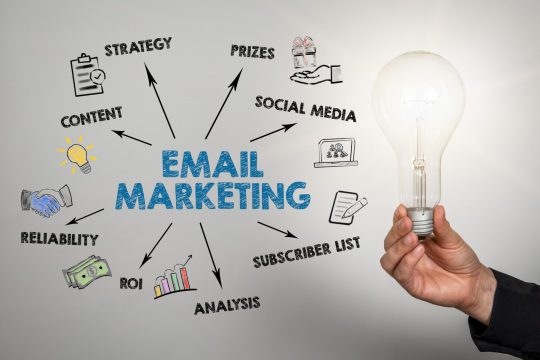
Measurable Results and Data-Driven Insights:
Email marketing is a powerful tool that offers measurable results and valuable data-driven insights for businesses. By utilizing email campaigns, companies can track various metrics such as open rates, click-through rates, and conversion rates to gauge the effectiveness of their marketing efforts. These metrics provide concrete data on how recipients are engaging with the emails, allowing businesses to make informed decisions based on real-time data. Analyzing this data is crucial for optimizing future email campaigns and making data-driven decisions.
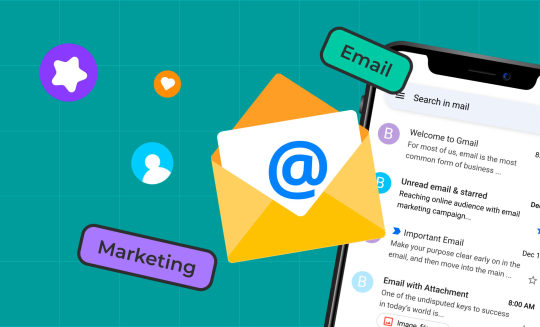
Conclusion:
In conclusion, the key advantages of email marketing highlighted in the blog post include its ability to reach a wide audience, cost-effectiveness, and high return on investment. By summarizing these benefits, readers can see how email marketing can help businesses connect with customers, increase brand awareness, and drive sales. It is highly recommended that readers seriously consider integrating email marketing into their overall business strategy to fully leverage its potential. By utilizing email marketing campaigns effectively, businesses can not only see immediate results but also experience long-term advantages such as sustained growth and increased success. Ultimately, the blog post emphasizes the importance of email marketing as a powerful tool for businesses looking to thrive in today’s competitive market.
#Analytics#Automation#BrandAwareness#BusinessBoost#ConversionRate#CostEffective#CustomerEngagement#CustomerRelationships#CustomerRetention#DigitalMarketing#EffectiveCommunication#EmailCampaigns#EmailMarketingBenefits#IncreasedSales#LeadGeneration#MarketingStrategy#MarketingSuccess#Personalization#ROI#targetedaudience
1 note
·
View note
Text
Optimizing Web Design: A Definitive Guide to Enhancing Your Digital Footprint

A Definitive Guide to Enhancing Your Digital Footprint
In the current era of Virtual prominence, possessing an outstanding web design is absolutely essential. Your website serves as the cornerstone of your online identity, influencing visitor engagement and ultimately, conversion rates. But what makes for the best web design? Let's delve into the essential elements and frequently asked questions surrounding this critical aspect of online success.
Understanding the Impact of SEO on Web Design
Creating a visually stunning website is only half the battle; it must also be optimized for search engines (SEO) to ensure maximum visibility. Learn how SEO intertwines with web design, and why it's imperative to integrate SEO practices throughout the design process.
Navigating the Essentials of User-Friendly Design
The hallmark of a great website lies in its ease of navigation. Discover how to craft intuitive menus, clear layouts, and streamlined user experiences that keep visitors engaged and coming back for more.
Tailoring Design to Your Target Audience
Appealing to your audience goes beyond aesthetics; it's about understanding their preferences and crafting a design that resonates. Explore the nuances of font choices, color palettes, and design elements that cater to your specific demographic.
Converting Visitors into Customers
The ultimate goal of web design is conversion. Learn proven strategies for incorporating clear calls-to-action, compelling imagery, and clean layouts that guide visitors seamlessly through the conversion funnel.
Embracing Mobile Responsiveness
In an era dominated by mobile devices, responsive design is non-negotiable. Uncover the importance of mobile-friendly websites, and how responsive design enhances user experience, boosts search engine rankings, and drives conversions.
Simplifying Maintenance for Long-Term Success
Maintaining your website is as vital as creating it. Explore strategies for easy upkeep, from intuitive design templates to streamlined navigation structures, ensuring your site remains fresh, relevant, and SEO-optimized.
Best Practices from Industry Experts
Gain insights from industry leaders and successful case studies, including real-world examples of effective web design strategies in action.
Your Path to Web Design Mastery
Empower yourself with the knowledge and tools needed to master web design and elevate your online presence. Whether you're a novice or seasoned pro, our comprehensive guide will equip you to create compelling websites that captivate audiences and drive business growth.
Unlock the Potential of Your Online Presence
Join us on a journey through the intricacies of web design, and unleash the power of your online presence. Stay informed, inspired, and ahead of the curve with our ultimate web design resource. Are you ready to transform your website into a digital masterpiece? Let's embark on this journey together. Welcome to the world of web design excellence
Conclusion
In mastering web design, understanding the critical role of SEO is paramount. A visually appealing website alone cannot guarantee success; it must also be optimized to rank well on search engines. By integrating SEO practices throughout the design process, from the layout to the content, websites can ensure maximum visibility and engagement. This not only enhances user experience but also boosts search engine rankings, driving organic traffic and ultimately leading to higher conversion rates.
In today's digital landscape, embracing mobile responsiveness is essential, considering the dominance of mobile devices. Responsive design not only caters to user experience but also contributes to SEO performance.
Frequently Asked Questions:
What techniques can be employed to increase conversions on a website?
Techniques such as clear calls-to-action, informative content, emotional imagery, and simple layouts can increase conversions. Following principles like Hick's Law and using high-quality images can also enhance conversion rates.
How can web design be tailored to appeal to a specific target audience?
Tailoring web design involves understanding the preferences of the target audience regarding fonts, colors, and design elements. By aligning design choices with audience preferences, websites can better resonate with their demographic.
What strategies can be used to convert website visitors into customers?
Effective web design strategies for conversion include clear calls-to-action, compelling imagery, informative content, and an easy-to-use interface. Limiting choices and using high-quality images can also enhance conversion rates.
How Can You Reach Our Team?
Email: [email protected]
Phone No: 01302-490-222
Website Url: https://doncasterwebservices.co.uk
#WebDesignTips#DigitalFootprint#WebsiteOptimization#UserExperience#ResponsiveDesign#SEOStrategy#MobileFriendly#VisualAppeal#ContentStrategy#ConversionRate#UXDesign#UIImprovement#WebDevelopment#OnlinePresence#BrandVisibility#SEOBoost#DigitalMarketing#GraphicDesign#WebTraffic#OnlineStrategy
0 notes
Text
Discover the power of tracking website calls and email clicks seamlessly with Google Analytics 4 and Google Tag Manager. Our step-by-step guide will equip you with the knowledge to decipher user behavior, fine-tune marketing strategies, and elevate your conversion rates effortlessly. Dive in and unlock the potential of data-driven insights!
#UnlockInsights#GoogleAnalytics#GoogleTagManager#DataDriven#ConversionOptimization#UserBehavior#MarketingStrategy#DigitalMarketing#Analytics#DigitalInsights#MarketingTips#OnlineMarketing#WebTraffic#Optimization#ConversionRate#DigitalStrategy#WebsiteAnalytics#TagManagement
1 note
·
View note
Text
WTD: CTR Vs Conversion Rate - GoDigital360Degree
CTR gets the attention; Conversion Rate seals the deal! 💸🧲
Let's define the spectrum of Digital Marketing with GoDigital360Degree ♾️
instagram
#godigital360degree#digitalmarketing#digitalmarketingagency#digitalmarketingservices#internetmarketing#digitalbranding#marketing#advertising#marketingstrategies#knowledgegraph#differentiation#clickthroughrate#conversionrate#difference#whatsthedifference#Instagram
0 notes
Text
Boosting Conversion Rates on Your Website through chat feature
Businesses are constantly looking for new ways to interact with their target audience and drive conversions across today's Digital World, where competition is fierce and attention spans are short. One of the very effective strategies that has gained popularity in recent years is integrating live chat into websites. This real-time communication tool not only improves customer service but also plays a role in increasing conversion rates. Let's explore how using live chat can turn your website into a conversion.
Immediate Response: Live chat offers clients a quick and helpful way to urge answers to their questions without having to scroll through FAQs or wait for answers via email. By advertising quick help, you'll meet the requirements of restless guests and direct them easily through the change preparation.
Personalized Engagement: Personal touch can significantly boost conversion rates by building rapport and trust with potential customers. This live chat feature allows businesses to deliver customized assistance based on individual preferences and browsing behavior. By leveraging data analytics and customer insights, you can tailor your responses and recommendations, creating a more meaningful and engaging visitor experience.
Improved Customer Support: With the support of live chat can enhance customer experience by providing immediate assistance and resolving issues promptly. Satisfied customers are more likely to convert and may even become repeat customers or advocates for your brand.
Opportunity for Upselling and Cross-Selling: Through chat, you can engage with visitors in real-time and suggest relevant products or services based on their interests and preferences. These present an opportunity to upsell or cross-sell, thereby increasing the average order value and overall conversion rates.
Lead Generation Opportunities: Chat can also help as a lead generation by capturing visitor information through pre-chat forms or by initiating conversations with proactive messages. These allow you to follow up with leads and nurture them through the sales funnel, ultimately increasing conversion rates.
Proactive Outreach: Don't wait for customers to reach out to you and take the initiative to engage with them proactively. Live chat enables you to trigger targeted messages or pop-ups based on specific actions or behaviors, such as time spent on a page or items added to the cart. By initiating conversations at strategic touchpoints, you can nudge visitors towards conversion and reduce cart abandonment rates.
Seamless Support: Providing exceptional customer support is crucial for driving conversions and fostering brand loyalty. Live chat offers a seamless support experience by allowing customers to connect with a representative in real time, regardless of their location or device. Whether it's addressing product inquiries, troubleshooting issues, or processing transactions, live chat empowers businesses to deliver prompt and efficient support, thereby enhancing the overall customer experience and boosting conversion rates.
In a digital ecosystem where customer experience reigns supreme, integrating a live chat feature into your website is no longer optional but also essential. By offering instant, personalized support and proactively engaging with visitors, businesses not only make conversions but also cultivate long-term relationships with customers. Embrace the power of live chat and unlock the full potential of your website as a conversion-driving machine.
0 notes
Text
Boost Your Business with Performance Marketing

In today's fast-paced digital landscape, businesses are constantly seeking innovative strategies to maximize their reach and drive growth. One such strategy that has gained significant traction in recent years is performance marketing. Performance marketing offers a highly targeted approach that allows businesses to track and measure the success of their marketing campaigns in real-time, ensuring a high return on investment (ROI) and increased profitability.
Table of Contents
Introduction to Performance Marketing
Understanding Performance Marketing Metrics
Choosing the Right Performance Marketing Channels
Optimizing Your Performance Marketing Campaigns
Case Studies: Real-World Success Stories
Future Trends in Performance Marketing
Conclusion: Embracing Performance Marketing for Business Growth
FAQs: Answering Common Questions
1. Introduction to Performance Marketing
Performance marketing is a results-driven approach that focuses on driving specific actions, such as clicks, conversions, or sales. Unlike traditional marketing methods, which rely on broad messaging and brand awareness, performance marketing allows businesses to target their audience with precision and measure the effectiveness of their campaigns in real time.
2. Understanding Performance Marketing Metrics
To succeed in performance marketing, it's essential to understand key metrics such as cost per acquisition (CPA), return on ad spend (ROAS), and conversion rates. By analyzing these metrics, businesses can identify which campaigns are delivering the best results and allocate their resources accordingly.
3. Choosing the Right Performance Marketing Channels
Performance marketing encompasses a variety of channels, including search engine marketing (SEM), social media advertising, affiliate marketing, and email marketing. By carefully selecting the right channels for their target audience, businesses can maximize their reach and engagement while minimizing wasted ad spend.
4. Optimizing Your Performance Marketing Campaigns
Continuous optimization is key to success in performance marketing. By testing different ad creatives, targeting parameters, and landing pages, businesses can identify what resonates most with their audience and refine their campaigns for maximum impact.
5. Case Studies: Real-World Success Stories
Examining real-world case studies can provide valuable insights into the power of performance marketing. By learning from the successes (and failures) of other businesses, entrepreneurs can gain inspiration and ideas for their own campaigns.
6. Future Trends in Performance Marketing
As technology continues to evolve, so too does the landscape of performance marketing. From the rise of artificial intelligence to the growing importance of data privacy, staying ahead of the curve is essential for businesses looking to remain competitive in the digital age.
7. Conclusion: Embracing Performance Marketing for Business Growth
In conclusion, performance marketing offers a powerful framework for businesses to achieve their marketing objectives and drive sustainable growth. By leveraging data-driven insights, targeting the right audience, and continually optimizing their campaigns, businesses can unlock new opportunities and propel their success in today's dynamic marketplace.
8. FAQs: Answering Common Questions
Q: What is performance marketing?
A: Performance marketing is a results-driven approach where businesses only pay for specific actions, such as clicks or conversions, rather than for ad placement.
Q: How does performance marketing differ from traditional marketing?
A: Unlike traditional marketing, which focuses on broad brand awareness, performance marketing is highly targeted and measurable, allowing businesses to track ROI more effectively.
Q: What are some common metrics used in performance marketing?
A: Common metrics include cost per acquisition (CPA), return on ad spend (ROAS), conversion rates, and click-through rates (CTR).
Q: What are the key channels for performance marketing?
A: Performance marketing channels include search engine marketing (SEM), social media advertising, affiliate marketing, and email marketing, among others.
Q: How can businesses optimize their performance marketing campaigns?
A: Businesses can optimize their campaigns by testing different ad creatives, targeting parameters, and landing pages, and analyzing the results to make data-driven decisions.
Q: What role does data analytics play in performance marketing?
A: Data analytics plays a crucial role in performance marketing by providing insights into audience behavior, campaign performance, and ROI.
Q: How can businesses stay ahead of the competition in performance marketing?
A: Businesses can stay ahead of the competition by staying informed about industry trends, leveraging advanced technologies, and constantly innovating their strategies and tactics.
Q: What are the challenges associated with performance marketing?
A: Challenges include ad fraud, attribution modeling, data privacy regulations, and the need for continuous optimization.
Q: How can businesses get started with performance marketing?
A: Businesses can get started by defining clear goals, identifying their target audience, selecting the right channels, and allocating sufficient resources for testing and optimization.
#PerformanceMarketing#BusinessBoost#MarketingMetrics#ConversionRate#DigitalAdvertising#GrowYourBusiness
0 notes
Text

Boosting ecommerce conversion rates isn't just about clicks, it's about crafting seamless user experiences, optimising checkout processes, and building trust. From persuasive product descriptions to intuitive navigation, every detail counts. Learn how your organisation can improve ecommerce conversion rates today.
0 notes
Text
Split Test Monkey V3 Review — Stop Wasting Traffic, Losing Subscribers, & Missing Sales, Start Testing Today!
WinDigiMarketing.com

Split Test Monkey V3 Review — Introduction
Have you ever felt like this? Are you tired of watching your hard-earned traffic go to waste, your subscriber list dwindle, and your sales slip through the cracks? Well, it’s time to put an end to the madness and start testing like a pro with our groundbreaking new tool!
Introducing the ultimate solution for maximizing your online business potential: a powerful tool that helps you stop wasting traffic, losing subscribers, and missing out on sales. With this game-changing software, you’ll be able to take the guesswork out of your marketing strategy and start testing like a seasoned pro.
Gone are the days of shooting in the dark and hoping for the best. With our innovative tool, you’ll have everything you need to conduct comprehensive tests and experiments that uncover what truly resonates with your audience. From tweaking your website design and optimizing your email campaigns to refining your sales funnels and testing new product offerings, the possibilities are endless.
But that’s not all-our tool also comes equipped with a brand new AI module that takes your testing capabilities to the next level. With the power of artificial intelligence at your fingertips, you’ll be able to analyze data faster, uncover hidden insights, and make smarter decisions that drive results.
And the best part? Testing doesn’t have to be a headache anymore. Our tool is designed with simplicity in mind, so you can set up tests, track results, and iterate on your strategy with ease. Whether you’re a seasoned marketer or just starting out, our intuitive interface makes it easy to get started and see results fast.
But don’t just take our word for it-join the thousands of satisfied users who have already transformed their online businesses with our tool. From small startups to Fortune 500 companies, our software has helped businesses of all sizes unlock their full potential and achieve greater success online.
So what are you waiting for? Stop wasting traffic, losing subscribers, and missing out on sales. Start testing like a pro with our powerful new tool and take your online business to new heights today!
>>> Get Split Test Monkey V3 With Discount and Valued Bonuses 👉👉👉 https://windigimarketing.com/split-test-monkey-v3-review/
Split Test Monkey V3 Review — What is it?
With the brand new version of Split Test Monkey V3 is designed to help you optimize your website’s performance and maximize your conversions. With Split Test Monkey V3, you can say goodbye to wasted traffic, lost subscribers, and missed sales by implementing effective split testing strategies and leveraging the power of artificial intelligence.
Split testing, also known as A/B testing, is a proven method for improving website performance by comparing different versions of a webpage to see which one performs better. With Split Test Monkey V3, you can easily set up and run split tests on various elements of your website, such as headlines, call-to-action buttons, images, and more.
The new AI module in Split Test Monkey V3 takes split testing to the next level by automatically analyzing your test results and providing recommendations for optimizing your website’s performance. Using advanced algorithms, the AI module can identify patterns and trends in your data, helping you make informed decisions about which elements to tweak and test next.
With Split Test Monkey V3, you have full control over your split testing experiments. You can create multiple variations of your webpages, set conversion goals, and track the results in real-time using the built-in analytics dashboard. Whether you’re a seasoned marketer or new to split testing, Split Test Monkey V3 makes it easy to run experiments and improve your website’s conversion rates.
One of the key benefits of Split Test Monkey V3 is its ease of use. The plugin is designed to be user-friendly and intuitive, with a simple interface that allows you to create and manage split tests with just a few clicks. You don’t need any technical expertise to get started — simply install the plugin on your WordPress site and you’re ready to go.
In addition to its powerful split testing capabilities, Split Test Monkey V3 also offers a range of other features to help you optimize your website for maximum conversions. These include customizable test durations, conversion tracking, statistical significance calculations, and more.
Overall, Split Test Monkey V3 is a must-have tool for any website owner or marketer looking to improve their conversion rates and maximize their return on investment. With its advanced features, user-friendly interface, and new AI module, Split Test Monkey V3 makes it easier than ever to optimize your website for success.
>>> Get Split Test Monkey V3 With Discount and Valued Bonuses 👉👉👉 https://windigimarketing.com/split-test-monkey-v3-review/
Split Test Monkey V3 Review — Features and Benefits
🔥FEATURES🔥
Built In Reporting & Awesome Features Make It Easy To Know You’re WINNING!
✅ Auto Optimizer
This is our favorite because it’s ‘set and forget’ simple to do. Just pick your test ‘rules’ such as how long the test runs, the minimum number of total conversions required before a winner can be called. Set a confidence level (normally 95%) and that’s it…
Split Test Monkey will then run the test on full autopilot and will automatically select the winner and from that point only show the winning element or page to all future visitors.
✅ Conversion Race
Conversion Races are a lot of fun and while they are a little less ‘solid science’ they lead to quick results (and often frantic betting in the office) :-)
Just choose how many conversions the winning element/page should hit for it to be declared a winner — For example: 1st page to hit 100 sales. You can also set a ‘margin’ number that ensures a winner isn’t called too early if it’s a close race.
Winners are then shown to all future visitors.
✅ Manual Mode
If you have an eye for detail and a desire to get stuck into the numbers directly, then choose the manual test mode.
You’re now in charge and the decision when to call the test will be yours alone.
There is no automatic selection by the system and you can run the test, edit it, even add more test elements into the mix and keep it running until you’re confident on the result.
>>> Get Split Test Monkey V3 With Discount and Valued Bonuses 👉👉👉 https://windigimarketing.com/split-test-monkey-v3-review/
🔥BENEFITS🔥
Here’s What You Get When You Create Your Account Today…
✅ Unlimited Split Tests
No limit to the number of experiments you can create.
✅ Unlimited Visitors
Unlike other services that want to ‘nickel & dime’ you, we’ll never cap the number of visitors/clicks you get.
✅ A/B Snippets & URLs
You can test both A/B page snippets AND full URLs and pages alternates, giving you flexibility on how you test.
✅ Set & Forget Testing
No limit to the number of experiments you can create.
✅ Built In Reporting
Use key data to understand customers and quickly make smarter decisions to boost your bottom line profits.
✅ VIP Level Support
You’ll get world-class, live chat support from our very friendly team, plus tutorials and training available 24/7.
>>> Get Split Test Monkey V3 With Discount and Valued Bonuses 👉👉👉 https://windigimarketing.com/split-test-monkey-v3-review/
Split Test Monkey V3 Review- Rating
👍 PRO
Split Test Monkey V3 aims to improve conversion rates by enabling split testing, allowing users to identify and implement changes that lead to higher conversions.
By optimizing landing pages and other elements through split testing, users can potentially increase their subscriber base, as evidenced by the claim of doubling landing page conversion rates and adding 200+ subscribers in a single week.
Split Test Monkey V3’s split testing capabilities can lead to increased sales revenue, as demonstrated by the claim of making an extra $570 in sales revenue in just one day through simple sales page video tests.
Users can also improve click-through rates on various elements, such as sidebar banners, by testing different designs or content variations, leading to increased engagement and traffic.
Split Test Monkey V3 likely features a user-friendly interface that simplifies the split testing process, making it accessible to users with varying levels of technical expertise.
👎 CON
While the plugin aims to simplify split testing, users may still require some technical knowledge to properly set up and configure tests, especially for more advanced testing scenarios.
Users should ensure that the plugin is compatible with their WordPress theme, other plugins, and any customizations they have made to their website to avoid compatibility issues.
Despite its user-friendly interface, users may need time to learn how to effectively use the plugin and interpret the results of split tests to make informed decisions.
>>> Get Split Test Monkey V3 With Discount and Valued Bonuses 👉👉👉 https://windigimarketing.com/split-test-monkey-v3-review/
Split Test Monkey V3 Review — My Opinions
Unlock the power of optimization with the latest version of the WordPress plugin from Split Test Monkey V3. This innovative tool is your secret weapon against wasted traffic, lost subscribers, and missed sales. By incorporating split testing into your marketing strategy, you can unleash the full potential of your website and maximize your results like never before.
Imagine being able to double your landing page conversion rate, add hundreds of subscribers to your list in just a single week, and generate hundreds of dollars in extra sales revenue in just one day. With the latest version of the Split Test Monkey WordPress plugin, these results are within your reach.
What sets this plugin apart is its ability to provide actionable insights that drive real results. By testing different elements of your website, such as landing pages, sales pages, and sidebar banners, you can identify what resonates most with your audience and optimize accordingly. Whether it’s the addition of a simple video, an animated GIF, or a minor tweak to your design, the plugin empowers you to make data-driven decisions that lead to tangible improvements in your conversion rates and revenue.
But the benefits of the Split Test Monkey plugin don’t end there. In addition to helping you optimize your website for maximum impact, it also saves you time and effort by automating the testing process. With its user-friendly interface and intuitive features, you can set up and run split tests with ease, allowing you to focus on growing your business while the plugin does the heavy lifting.
Moreover, the plugin’s comprehensive reporting capabilities provide you with valuable insights into your website’s performance, allowing you to track your progress and make informed decisions moving forward. Whether you’re a seasoned marketer or a novice, the Split Test Monkey WordPress plugin equips you with the tools you need to succeed in today’s competitive online landscape.
Split Test Monkey V3 offers a game-changing solution for maximizing the effectiveness of your website. With its advanced split testing capabilities and user-friendly interface, it empowers you to optimize your site for maximum conversions and revenue. Say goodbye to wasted traffic and missed opportunities, and hello to a future of success with the Split Test Monkey WordPress plugin.
>>> Get Split Test Monkey V3 With Discount and Valued Bonuses 👉👉👉 https://windigimarketing.com/split-test-monkey-v3-review/


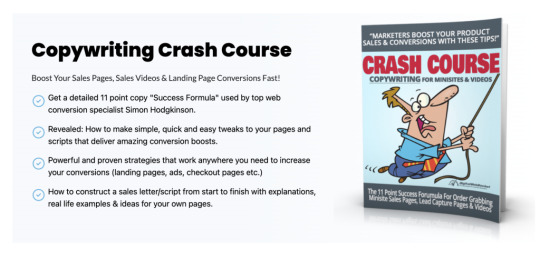
>>> Get Split Test Monkey V3 With Discount and Valued Bonuses 👉👉👉 https://windigimarketing.com/split-test-monkey-v3-review/
Split Test Monkey V3 Review — Who Should Use Split Test Monkey V3?
Just A Few Different Test Ideas That ANY Online Business Owner Can Do Right Now!
✅ Email List Builders
Boost your subscriber rates and grow your list faster by testing your landing pages, from the lead magnets to the color of your sign-up buttons.
✅ Product Vendors
Convert more sales and build bigger profits all hands free by testing sales and upsell pages, headlines, bullet points, pricing and calls to action.
✅ Affiliate Marketers
Get more clicks and bigger commission checks on offers you promote — Test your affiliate promo pages, bonus and review pages etc.
✅ Social Media Marketers
Grow your following and boost traffic the easy way by testing share button placement/styles, testing calls to action and more.
✅ Media Buyers & Advertisers
Reduce your advertising costs and increase your ROI fast by testing your ad copy and creatives, landing pages, trip wires and more.
✅ Ecommerce/Store Owners
Build your brand and explode your bottom line profits by testing price points, shipping rates, product shots and even checkout page styles/templates.
✅ Bloggers
Increase your site stickiness and audience engagement by testing post and page layouts, font sizes and styles, post images, banner ads, opt-in forms and much more.
✅ Authors / Publishers
Boost sales by split testing ads and media campaigns, cover designs, book titles, chapter/blurb copy, pricing and even formats available to readers.
>>> Get Split Test Monkey V3 With Discount and Valued Bonuses 👉👉👉 https://windigimarketing.com/split-test-monkey-v3-review/
Split Test Monkey V3 Review — Price and Evaluation
Split Test Monkey V3 has 1 Front End and 1 Upsell as follows;
✅ Front End: Split Test Monkey V3 — ($47 / $67 / $97)
🌟 Personal — For 1 Domain — ($47)
🌟 Business — For 10 Domains — ($67)
🌟 Agency — For 100 Domains — ($97)
✅ Upsell 1: STM Auto Campaigns per 5 Pack — ($37)
>>> Get Split Test Monkey V3 With Discount and Valued Bonuses 👉👉👉 https://windigimarketing.com/split-test-monkey-v3-review/
Split Test Monkey V3 Review — FAQs
❓ Are There Any Long-Term Commitments Or Contracts?
No, you can choose to cancel your subscription at anytime.
❓ Can I Access My Account From Anywhere?
Yes, Split Test Monkey is web-based platform which means you can access your data, your administrator area and create new tests from any computer with a browser.
❓ Do You Offer A Guarantee?
Yes we do. SplitTestMonkey.com comes with a 30-day money-back guarantee.
❓ The real key to successful testing is traffic volume.
The lower the traffic numbers, the larger the difference in conversion rate needs to be to decide on a winner. Statistical significance depends on numerous factors but the most important is driving enough traffic to the test to have confidence that the test showing the highest conversion is genuinely a ‘winner’
Quality of traffic is next. If you direct thousands of untargeted visitors to a test (visitors who are unlikely to ever become subscribers or customers) then you’ll see corrupted results. Traffic should always be targeted, visitors who will be interested in what you sell or offer.
Finally, Test Smart: We recommend you limit each tests to a single element on your pages, determine a winner and then create additional tests for other elements. (Elements are things like your headlines, the order buttons, page images, colors, call to actions etc.) The more variations you have in a single test the longer it will take (or the more traffic you will need) to determine what’s working.
>>> Get Split Test Monkey V3 With Discount and Valued Bonuses 👉👉👉 https://windigimarketing.com/split-test-monkey-v3-review/
Conclusion
I appreciate you taking the time to read my Split Test Monkey V3 Review. I pray that you found this information useful in making your purchase. There are a lot of perks for those that purchase this system before the general public. For the best price, you should move quickly. 😊
More Alternative Marketing Tools and Softwares:
Mail Mate — Brand New AI Email App Complies With the Latest Gmail & Yahoos February 2024 Update. Send Unlimited Emails to Unlimited Subscribers With Free SMTP!
VoiceGenesis AI — The #1-Ever A.I. Voice Cloning Platform Built For Marketers — Clone Your Voice Or Create Custom, Unique AI Voices In Seconds!
PrimeCloud AI — The Brand New Next Generation Technology To Do Unlimited Cloud Storage At One-Time Fee For Life!
AI Press — The New ChatGPT Powered Software Creates 100% Done For You and Ready To Profit Affiliate Sites With the Power of AI!
Host Ai– Get Unlimited Domains, Hosting, Bandwidth For A Low, 1-Time Price No Monthly Fees, Ever!
Originally published at https://windigimarketing.com on February 13, 2024.
#SplitTestMonkeyV3Review#SplitTestMonkeyV3#ConversionRate#MakeExtraRevenues#IncreasedClicks#SalesPages#ExtraMoney#onlinemarketing#makemoneyonline#sidehustles#workfromhome#internetmarketing#marketingtools#marketingMaterials
0 notes
Text

Optimizing Ecommerce Checkout for Maximum Conversions
In the highly competitive world of ecommerce, the success of your online store hinges significantly on the efficiency of your checkout process. Research indicates that nearly 70% of potential customers abandon their online shopping carts during the checkout process, emphasizing the critical role that the checkout page plays in your conversion rate optimization (CRO) strategy.
Here at RMRKBL Marketing, we explain how to optimize your checkout for maximum.
1. Establish Trust Signals Throughout Checkout
Building trust is paramount in ecommerce. Trust signals, such as HTTPS certificates, customer testimonials, influencer endorsements, payment processor logos, and clear shipping and returns policies, play a crucial role in reassuring customers that their sensitive information is secure. Incorporating these trust signals seamlessly throughout the checkout process reinforces the credibility of your ecommerce website.
2. Prioritize Mobile-Friendly Checkout
In a digital landscape where mobile devices are ubiquitous, optimizing your checkout process for mobile users is non-negotiable. A significant portion of consumers, approximately one-third of US internet users, makes purchases via their mobile devices weekly. Ensure your checkout pages automatically resize for smaller screens, feature large finger-friendly buttons, and maintain a visually appealing layout.
3. Utilize Checkout Progress Bar Strategically
Streamlining the checkout flow is essential. Studies show that minimizing unnecessary form fields increases the likelihood of completing the checkout process. However, if your ecommerce model requires additional information, consider incorporating a progress bar. This indicator informs customers about the completion status, reducing abandonment rates and providing transparency.
4. Diversify Payment Methods
Offering multiple payment options is a critical aspect of checkout optimization. Studies indicate that 70% of customers abandon the checkout process if their preferred payment method is unavailable. Embrace various payment options, including shopping apps, credit/debit cards, buy now pay later services, and digital wallets, to cater to a broad audience, as observed in Helm Boots' checkout.
5. Streamline Address Entry with Autofill
Addressing the issue of prolonged checkout flows, implement Google Autocomplete to autofill shipping and billing addresses. This not only expedites the process but also reduces errors on mobile devices by 20%, enhancing overall user experience.
6. Boost Revenue with Upsells and Cross-Sells
Maximize the value of each transaction by incorporating upsells and cross-sells. An upsell suggests a higher-priced product, while cross-selling recommends complementary items. Kettle and Fire's checkout design serves as a prime example of strategically offering additional products, increasing the average order value and overall revenue.
7. Optimize Guest Checkout
Recognizing that a quarter of customers abandon their carts due to forced account creation, provide alternatives such as guest checkout or social media account logins. Ban.do's use of Shopify Checkout without mandatory account creation is an effective strategy to keep shoppers engaged.
8. Integrate Live Chat Support
Acknowledge that not all customers are ready to make an immediate purchase. Integrate live chat support throughout the checkout process to address last-minute concerns. Consonant's ecommerce store, with a live chat icon on every page, exemplifies the importance of real-time assistance.
9. Expedite Checkout with 1-Click Checkout
Implement 1-click checkout features like Shop Pay to drastically reduce the time it takes for customers to complete their orders. Thesus, a sustainable brand, showcases how a single button can significantly boost conversions by 35.62%.
10. Conceal Discount Code Field Strategically
Recognizing that many shoppers use discount codes, strategically position the discount code field to enhance user experience. Consider hiding it behind a dropdown, ensuring it is accessible but not intrusive, as demonstrated by Shopify's mobile interface.
11. Transparent Pricing to Reduce Abandonment
Inform customers upfront about any additional costs, such as shipping, customs, or taxes, to minimize surprises. Momofuku's approach of reminding customers about free shipping based on order value is an effective way to address potential concerns.
Why Checkout Optimization Matters
Your checkout page is the final touchpoint before a customer makes a purchase, making it a pivotal aspect of your ecommerce strategy. Key considerations include offering multiple payment options, ensuring a clean and navigable checkout design, suggesting compatible items for upselling, emphasizing shipping savings, and providing a seamless mobile checkout experience.
Shopify's commitment to optimizing the checkout process, with Shop Pay offering a 50% better conversion over guest checkout, underscores the significance of this stage in maximizing revenue. By focusing on eliminating conversion barriers, your ecommerce checkout page becomes a powerful tool to leave a lasting impression on customers and encourage repeat business.
FAQs
What is an ecommerce checkout?
Ecommerce checkout is the final stage of an online store's website where customers complete a purchase. It involves entering shipping information, choosing shipping options, entering payment details, and may include editing the cart or adding promo codes.
What makes a good checkout experience?
A good ecommerce checkout experience is fast, easy, and trustworthy. This may involve features like guest or social media login, minimal form fields, 1-click checkout, and the use of security badges or familiar payment options to build trust.
How do you upsell at checkout?
Upselling at checkout involves suggesting additional items for customers to add to their carts. Shopify apps like Zipify, Zoorix, and In Cart Upsell enable merchants to seamlessly incorporate upsells during the checkout process.
Why do customers abandon their carts?
Studies show that reasons for cart abandonment include high or unexpected extra fees, unavailable preferred payment options, a cumbersome or confusing checkout experience, or simply browsing without the intent to purchase.
How do you reduce ecommerce checkout abandonment?
To reduce ecommerce checkout abandonment, enable mobile checkout, keep forms short, consider single-page checkout, eliminate extra shipping costs, offer alternative payment options, hide promo code fields strategically, and allow guest checkout.
What are some trust signals in ecommerce checkout?
Trust signals in ecommerce checkout include HTTPS certificates, customer testimonials, influencer endorsements, payment processor logos, and transparent shipping and returns policies. These signals reassure customers that their sensitive information is secure.
How can I integrate live chat support in the checkout process?
Integrating live chat support in the checkout process involves using tools like Shopify Inbox. This allows merchants to communicate with customers in real-time, providing answers to queries related to returns policies, shipping delays, and product-related questions.
How does transparent pricing reduce cart abandonment?
Transparent pricing, including informing customers about additional costs like shipping, customs, or taxes, reduces cart abandonment by eliminating surprises. By presenting this information upfront or offering free shipping based on order value, customers are less likely to abandon their carts.
#Ecommerce#CheckoutOptimization#ConversionRate#OnlineBusiness#DigitalCommerce#ShopifyTips#RetailRevolution#EcommerceSuccess#startup#digital marketing#e-commerce#localbusiness#marketing#seo#seo agency#seo company#entrepreneur
1 note
·
View note
Text

Digital marketing enables businesses to reach a vast audience cost-effectively through online channels like social media, email, and search engines. It offers real-time tracking and analysis for prompt strategy adjustments, enhancing efficiency and ROI. Moreover, it fosters better customer engagement through personalized content, leading to increased brand loyalty and customer retention, ultimately helping businesses achieve their marketing goals effectively.
#DigitalMarketing#Benefits#Growth#Traffic#SiteAnalytic#Content#SalesGrowth#OnlinePresence#SEO#SocialMedia#Engagement#ConversionRate#BrandAwareness#EmailMarketing#InfluencerMarketing#PPC#LeadGeneration#CustomerRetention#DataAnalysis#MarketingStrategy
0 notes
Text
14 Tips for Effective Pay Per Click Advertising
Discover the secrets to successful Pay Per Click advertising with our 10 expert tips. Maximize your online marketing efforts and boost your ROI today.
What is Pay Per Click Advertising?
Pay-per-click (PPC) is a form of online advertising where advertisers pay a fee each time their ad is clicked. This model allows businesses to drive traffic to their websites by paying for visits, rather than relying solely on organic traffic. Pay Per Click advertising campaigns are typically managed through platforms like Google Ads or Bing Ads, where advertisers bid on keywords relevant to their target audience.
The Basics of Pay Per Click Advertising:
Pay Per Click Advertising is used for all types of campaign goals, including:
Increasing sales
Generating leads
Promoting brand awareness
Pay-per-click advertising revolves around the concept of relevance. Individuals are actively seeking particular products, services, or information at various points in time. Advertisers possess the capability to display a tailored advertisement precisely when this search is taking place. For instance, when a user looks up “Loafer Shoes For Men,” an advertiser can present an ad specifically addressing “Loafer Shoes For Men.”

Main Platforms:
Google Ads:
Google Ads, the largest pay-per-click platform, operates on Google, Search Partner sites, and Display Network sites. Since its launch in October 2000, Google Ads has undergone numerous transformations over the past 17 years. It caters to a wide range of businesses, from small enterprises to Fortune 500 companies.
Microsoft Advertising:
Microsoft advertising, similar to Google Pay Per Click Advertising, operates as a Pay Per Click advertising platform that showcases ads on the Microsoft and Yahoo networks. It also incorporates Search Partners. Microsoft advertising is primarily focused on keyword-based advertising. In 2017, Microsoft Advertising had 137 million unique desktop searchers on the Bing Network.
Account Structure:
Campaigns and Ad Groups:
The process commences with advertisers selecting keyword themes and establishing individual campaigns. To illustrate, a Pay Per Click advertising professional may create a campaign centered around the theme “Coffee Tables”. Within this campaign, there are categorized subgroups referred to as ad groups. These ad groups may consist of:
Oval Coffee Tables
Long Coffee Tables
Round Coffee Tables
Keywords:
Each keyword must be assigned a specific match type that determines the queries for which ads will be displayed. There are a total of seven match types for keywords.
Exact – The query must be entered exactly as it is, without any variations or changes.
Exact (Close Variant) – The query must be entered exactly as it is, including any misspellings or variations.
Phrase – The query must be typed in the correct order, regardless of any additional terms before or after it.
Phrase (Close Variant) – The query must be entered in the correct sequence, regardless of any extra terms preceding or following the query. The query may contain misspellings or alternative variations.
Broad – The query can be entered in any sequence and may display advertisements for related searches.
Modified Broad – The Modified Broad match type allows for queries to be entered in any sequence, as long as they include terms with a plus sign.
Broad (Session-Based) – Is a form of broad match that considers the user’s search session and takes into account other queries made by the user.
Here is a table of the match types, keywords, and potential search queries.
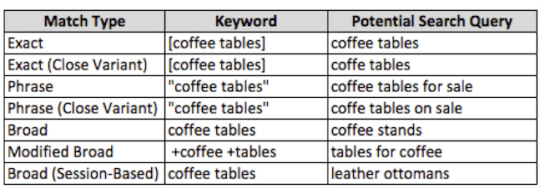
Negative Keywords:
Negative keywords can be utilized to eliminate unqualified traffic in addition to positive terms. For instance, if someone searches for “free coffee table,” they are not likely to make a purchase. By including “free” as a negative keyword, the advertiser’s ad will not be displayed when a query with this term is entered. In the case of a company selling high-end products, negative keywords such as “bargain” or “cheap” may be effective in filtering out irrelevant searches.
Audiences:
Audiences consist of categorized users and are commonly utilized in remarketing strategies. They can be tailored according to factors such as pageviews, duration of site visits, number of pages visited, and other criteria. Similar to keywords, audiences are targeted based on their relevance, with advertisers potentially bidding higher to target specific groups like shopping cart abandoners compared to homepage visitors.
Pay Per Click Advertising Copy:
Expanded Text Ads:
After creating ad groups and selecting keywords, it is time to craft the ads. The ads must incorporate the targeted keyword theme, highlight any value propositions, and include a compelling call to action.
The structure and character limits for Google Ads text ads are outlined below.
Headline 1: Limited to 30 characters
Headline 2: Restricted to 30 characters
Description Line: Maximum of 80 characters
Path 1: Up to 15 characters
Path 2: Up to 15 characters
Advertisements must refrain from using too much capitalization, punctuation, or deceptive claims. It is important to remember that the display URL will merge the root of the final URL with Path 1 and Path 2.
It is significant to mention that both Microsoft and Google have replaced traditional Text Ads with Expanded Text Ads. Although Google Ads still allows the use of traditional ads, advertisers are no longer able to create new versions of this format. The traditional ad format included a 25-character headline and two 35-character description lines.
Every ad group should contain at least two ads for testing purposes. Here is an example of an “oval coffee tables” ad:
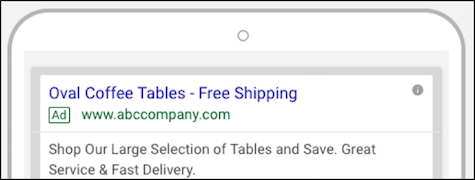
Ensure that your ad copy is compatible with both desktop and mobile devices by writing a single version that will be automatically adjusted for both formats. Keep in mind that the copy will be displayed on both platforms, so make sure it is optimized for both desktop and mobile users.
After clicking, visitors will be directed to a landing page that extends the advertisement’s message. This designated page, known as the landing page, will showcase a variety of oval coffee tables accompanied by information about complimentary shipping.
Product Listing Ads (PLAs):
Product titles, images, and prices are featured in square units called Product Listing Ads, which are commonly used in eCommerce Pay Per Click advertising campaigns.

Google product feeds are used by PLAs, which need to be linked to a Google Merchant Center account. On the other hand, Microsoft Advertising has a comparable feature called Product Ads, which also necessitates the use of a Bing Merchant Center account.
Image Ads:
Advertisers have the option to launch Display Network campaigns featuring image ads, which are displayed on numerous sites within and around the content of the Display Network.
200 × 200
240 × 400
250 × 250
250 × 360
300 × 250
336 × 280
580 × 400
120 × 600
160 × 600
300 × 600
300 × 1050
468 × 60
728 × 90
930 × 180
970 × 90
970 × 250
980 × 120
320 × 50
320 × 100
Settings:
Pay Per Click Advertising Campaign Types:
Search Network – The Search Network is the most frequently used targeting option, comprising Google.com and Google’s Search Partners like aol.com, amazon.com, and others. It primarily focuses on keyword-based Pay Per Click advertising, displaying ads when users enter relevant search queries.
Pay Per Click Advertising Display Network – The Display Network comprises numerous websites that display Google text, image, and video ads within their content. Instead of relying on traditional keyword targeting, these ads focus on audiences and demographics. For instance, a user browsing a blog about coffee table history may come across an ad related to coffee tables, increasing brand awareness even if they are not actively looking to make a purchase.
Search Network with Display Opt-In –Is a blend of both networks, replacing the Search Network with Display Select in the new Google Ads interface. By creating a standard Search Network campaign and choosing to opt in to the Display Network, advertisers allow Google to decide the optimal time and place for ad performance, relinquishing some control. While it is recommended to separate campaigns by network, experimenting with Search with Display Opt-In is advisable.
Shopping: Product Listing Ads – Google and Microsoft display Product Listing Ads (PLAs) for shopping purposes. To create shopping campaigns on Google Ads, advertisers need to submit a product feed to Google Merchant Center. Advertisers can then create product groups and bid on different feed attributes such as price, brand, and availability.
Brand
Category
Condition
Item ID
Product Type
Custom Attributes
Shopping campaigns do not utilize keywords; instead, search engines match user queries to the most relevant product. Therefore, it is crucial to maintain accurate information, clear titles, and descriptions for all products.
Pay Per Click Advertising Device Targeting:
Pay Per Click advertising can be shown across all devices, including:
Desktops/Laptops
Tablets
Mobile Devices
Search engines treat desktops/laptops and tablets as similar platforms, applying the same bid to both. However, mobile devices have the option for bid modifiers. For instance, if the bid is $1.00 and the mobile bid modifier is set to -50%, the bid on mobile devices would be reduced to $0.50. Conversely, a bid modifier of 150% would increase the mobile bid to $1.50.
Pay Per Click Advertising Location Targeting:
PPC targeting offers a high level of granularity, reaching down to the zip code level, allowing advertisers to specify where their ads will appear. For instance, a campaign can be set up to exclusively target Iowa, ensuring ads are only shown in that specific location.
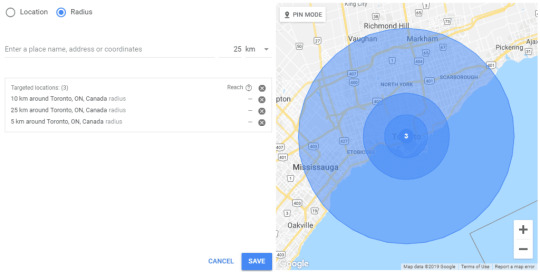
Pay Per Click Advertising Scheduling:
Advertisers can choose specific times to run ads, enabling eCommerce campaigns to run 24/7 while brick and mortar stores can display ads only during business hours, making ad scheduling a convenient way to manage when ads are shown. Bid modifiers can also be adjusted for days and hours, such as increasing bids by 20% on weekends for higher revenue or decreasing bids by -80% during low-quality traffic periods like midnight to 4 AM.
Pay Per Click Advertising Budget:
A daily budget is allocated for each individual campaign, and it is important to create budgets that align with the goals of the account.

Pay Per Click Advertising Delivery Method:
Two choices are available for ad delivery: standard and accelerated. The standard method displays ads evenly over the course of the day, suitable for advertisers with budget constraints. On the other hand, the accelerated method shows ads until the budget runs out, ideal for advertisers without budget limitations who want their ads to appear for every query.
Pay Per Click Advertising Delivery:
There are two options for which your ads will be delivered by Google:
Optimize – Delivery is based upon ads expected to produce higher click volume.
Rotate indefinitely – Ads are delivered more evenly into the ad auction, but they are not optimized toward any kind of goal like clicks or conversions.
Technical Pay Per Click Advertising:
Pay Per Click Advertising Conversion Tracking:
Advertisers possess the capability to establish conversion objectives to assess the performance of their accounts. Both platforms offer code snippets that can be inserted on crucial pages, typically order confirmation or thank you pages. Advertisers can ascertain if ad clicks are resulting in conversions.
Google Ads allows many types of conversion tracking, including:
Webpage
Mobile or tablet app
Calls from ads using call extensions
Calls to a Google forwarding number on your website
Clicks on a number on your mobile website
Imported goals (from third party platforms like Salesforce)
Google Analytics:
To gain insights into post click behavior, it is advisable to connect Google Ads accounts with Google Analytics accounts. This linkage offers a comprehensive view of the conversion funnel. To establish the connection, simply input the Google Ads ID number in the “Admin” section of Google Analytics.
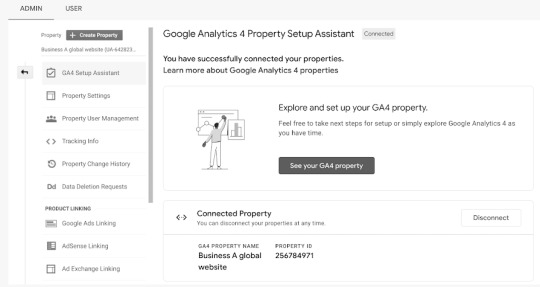
Once added, the connection can be confirmed by navigating to “Account Settings” and then “Linked accounts.” The “View details” section will show the link.
The account can also be linked to Webmaster Tools, which will show how ads and the organic listings perform.
Google Merchant Center:
To execute Google Shopping campaigns, also known as PLAs, the Google Merchant Center account needs to be linked with Google Ads. Just like with Google Analytics, the Google Ads ID should be inputted in the “Settings” area of the Merchant Center account. The account information for Merchant Center will be displayed in the “Tools” section of Google Ads once the connection is established.
Pay Per Click Advertising Remarketing:
Establishing the Google remarketing code involves a straightforward procedure. The remarketing tag is located within the Shared Library and must be copied onto each page of the website before the closing </body> tag. To ensure accuracy, the code can be verified by revisiting the Shared Library.
Pay Per Click Advertising Extensions:
Ad extensions serve as extra links and details that provide additional information about your business, thereby enhancing the basic PPC ads. While some ad extensions can be manually selected and controlled by you, search engines may also generate certain ad extensions automatically. The primary benefit of ad extensions lies in their ability to boost the click-through-rate (CTR) of the ad headline, as they increase the size of the ads and make them more noticeable on the search engine results pages (SERPs). Numerous ad extensions are available to choose from.
Sitelink Extensions:
Sitelink extensions provide extra links for users to explore more pages on your site, and they are manually inserted in Google and Microsoft interfaces. It is important for sitelinks to be related to the search query, and they can also feature descriptions called enhanced sitelinks.
Location Extensions:
Brick and mortar businesses can greatly benefit from using location extensions. These extensions display the business address and can be utilized on both Google and Microsoft platforms. However, it is important to note that in order to use location extensions on Google, a Google My Business account must be set up and linked to Google Ads.
Call Extensions:
Advertisers have the option to utilize call extensions on both Google and Microsoft platforms, providing two different opportunities. These extensions enhance ads on mobile devices by allowing users to easily make a call with a click, making it convenient for mobile searchers to contact the business. It is important to note that call extensions are now included in Google Ads’ dynamic ad extension choices. If phone calls do not benefit your business, it may be wise to disable this feature.
App Extensions:
Google offers a useful feature called app extensions or application extensions, which is beneficial for businesses aiming to boost application downloads and user engagement.
Consumer Ratings Annotations:
Consumer rating extensions are allocated selectively to specific businesses and industries at Google’s discretion.
Seller Ratings Extensions:
Seller Ratings function akin to consumer ratings, automatically sourced by Google from reputable website reviews.
This extension considers the entire business process as well. Companies that effectively implement rating and review extensions establish procedures to regularly request feedback from customers. Search engines also implement procedures to detect fake reviews. A key aspect of this process is the natural progression of ratings. For instance, if a company were to receive fifty 5-star ratings in a single month, it would raise suspicions of potential fraudulent reviews to search engines.
Pay Per Click Advertising Tools:
PPC is an amazing field to work in. The primary goal of search engines is to maximize revenue, and as account managers, it is our responsibility to handle the spending. Search engines are motivated to keep budget managers satisfied and offer tools to justify increasing expenditure. Let’s take a look at some tools that can enhance the effectiveness of a PPC campaign.
Pay Per Click Advertising Change History:
Historical modifications are accessible in Google Ads and Microsoft Advertising, documenting previous changes such as bid adjustments and sitelink inclusions. The information contains the username or email associated with the alteration and the timestamp of the adjustment. It is possible to export the change history.
Keyword Planner:
The Keyword Planner, a feature available on Google Ads, assists in identifying and organizing campaigns, keywords, and ad groups. It also offers performance data estimates that can be utilized to determine initial bids and budgets for PPC accounts.
Display Planner:
The Display Planner serves as a valuable resource for designing Display Network campaigns. It provides a comprehensive list of websites, keywords, topics, and interests that are relevant to your target audience. By utilizing this tool, you can discover numerous new websites, apps, and video channels that are recommended for your campaign.
Pay Per Click Advertising Preview and Diagnostics:
The Ad Preview and Diagnostics tool assists in determining the reason why your ad may not appear for a specific search term, and can be accessed through the Google Ads Interface. Simply input the location and language, and the tool will analyze in the background to provide results.
Pay Per Click Advertising Opportunities:
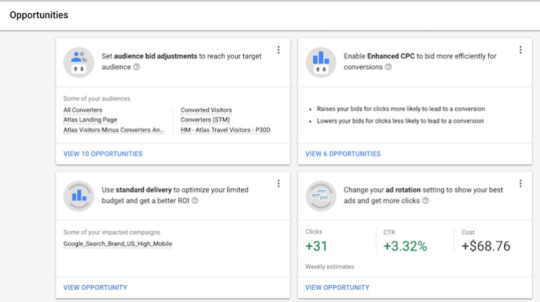
Pay Per Click Advertising Labels:
Labels serve as virtual sticky notes and embedded documentation for campaigns, ad groups, keywords, and ads. They offer versatility, allowing for various applications such as indicating ad creation dates or identifying top-performing keywords. Labels prove particularly valuable in accounts managed by multiple individuals or when dealing with distinct segments that have different objectives. By correctly implementing labels, evaluating the performance of a particular initiative becomes significantly more streamlined.

Pay Per Click Advertising Automated Rules:
Google Ads features exclusive automated rules that can be configured based on various performance metrics and scheduled to run accordingly. These rules aim to streamline account management, yet human oversight should not be entirely replaced. It is advisable to establish performance thresholds or safety rules to address any potential decline in performance.
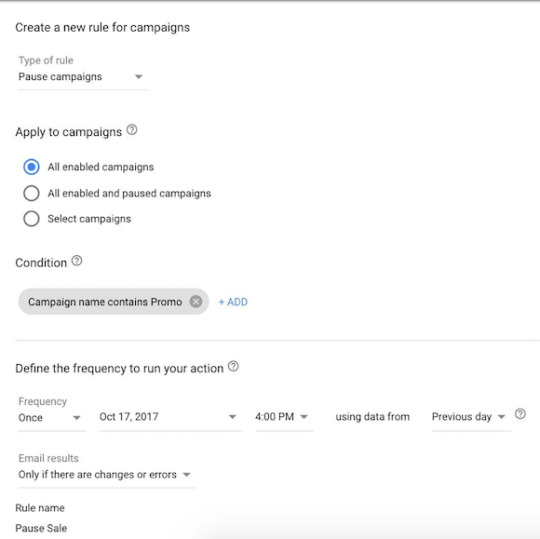
Pay Per Click Advertising Shared Library:
The Google Ads shared library allows advertisers to manage changes across multiple campaigns.
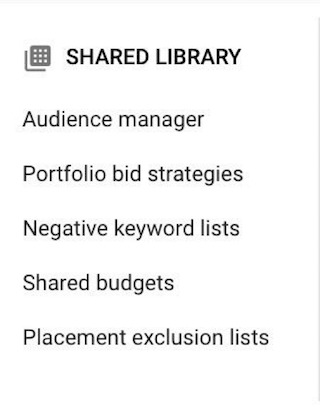
Audiences:
Audiences can be added to Display, Remarketing, and Remarketing Lists for Search Ads campaigns.
Pay Per Click Advertising Bid Strategies:
Automated bidding strategies, known as bid strategies, involve relinquishing control to the search engine to adjust auction bids based on preset goals. These bid goals are established in the shared library, allowing the search engine to utilize algorithms for bid adjustments. Various strategies can be implemented at both the campaign and ad group levels.
Enhanced CPC
Target Search Page Location
Target CPA
Maximize Clicks
Target Return on Ad Spend (ROAS)
Maximize Conversions
Pay Per Click Advertising Budgets:
In most cases, daily budgets are allocated for each campaign. However, there are instances when you may need to reallocate these funds based on campaign performance. The shared budget feature eliminates the need to manually manage and monitor individual campaign budgets. By using a shared budget, Google Ads will automatically adjust the budget for the entire account or a group of campaigns within the account.
Pay Per Click Advertising Campaign Negative Keywords:
Managing negative keywords through the shared library is a time-saving practice for adding them to multiple campaigns. Account managers often have standard lists of adult terms or industry exclusions that can be maintained in the shared library, allowing for efficient management. These lists can be applied account-wide or to specific campaigns within the account.
Pay Per Click Advertising Campaign Placement Exclusions:
Similar to negative keywords, certain websites in Display campaigns have low conversion rates. By including a list of campaign placement exclusions, this list can be shared across multiple Display campaigns.
Pay Per Click Advertising Reporting:
Pay Per Click Advertising Search Query Reports (SQRs):
Search query reports are incredibly valuable and represent a key optimization method. By running SQRs on Google and Microsoft, irrelevant search queries can be identified and added as negative keywords. Furthermore, these reports can uncover fresh ideas for expanding keywords. It is advised to conduct SQRs at least twice a month.
Pay Per Click Advertising Placement Reports:
Placement reports display the websites in the Display network where your ad has appeared. You have the option to modify bids for specific websites or block websites that are generating traffic with low conversion rates. It is recommended to conduct a placement report at least biweekly.
Pay Per Click Advertising Auction Insights Report:
This report, available in Google Ads, is utilized to identify the companies that are vying against your business in the search auctions. The Auctions Insights Report provides valuable insights into your impression share compared to your competitors, helping you decide whether to boost bids and/or budget to enhance competitiveness in the auction. Additionally, it helps in recognizing if you are competing with businesses from different industries, prompting the need to incorporate negative keywords in your campaigns or reevaluate the keywords you are bidding on.
Pay Per Click Advertising Segmentation Options:
When generating reports in search engines, you will always find the ability to segment your data further. You have the option to segment by device, time, network, and various other criteria. With numerous options available, you can achieve the level of detail you need. These segmentation features can be accessed on multiple tabs within Google Ads. Keep in mind that certain segments may only be applicable to specific subsets of data, while others can be discovered after downloading the report from the interface.
Pay Per Click Advertising Filters:
Filters are a valuable feature in both Google Ads and Microsoft Advertising, allowing users to create and save filters for efficient campaign analysis. These filters prove particularly beneficial when dealing with extensive campaigns, as they enable users to break them down into smaller, more manageable segments. By filtering based on various performance data, users can easily make bid adjustments or take other actions to align with their objectives.
Pay Per Click Advertising Columns:
Columns serve as an additional cross advertising platform element that displays predetermined metrics. They are customizable on all tabs across the engine interfaces, allowing for the inclusion of various data points like assisted conversions, competitive impression share metrics, conversion data calculations, and more. Columns provide a valuable tool for tailoring the interface to meet your specific goals and analytical requirements.
Pay Per Click Advertising Display Network:
The Display Network offers a valuable opportunity to increase traffic volume compared to search. While the average cost per click is typically lower on the Display Network, the quality of traffic may not always be as high. It is crucial to thoroughly test all targeting options within the Display Network to guarantee the arrival of high-quality traffic.
Pay Per Click Advertising Targeting Options:
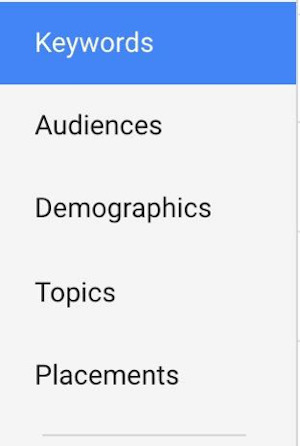
Display Keywords:
Utilizing keywords on the Display Network is known as contextual targeting. These keywords align your ads with websites that share similar themes. For example, the Display keyword “shoes” will be matched with any website that Google identifies as being related to shoes. Unlike search keywords, these keywords are not interpreted literally and are all classified as broad match. Keywords within an ad group function more like a theme. Display keywords can be utilized independently or in conjunction with other targeting methods to narrow down the scope and enhance quality.
Placements:
Placements refer to the specific websites or platforms where your Display ads are displayed. You have the option to allow Google Ads to automatically select placements based on your targeting preferences, or you can manually choose the placements where your ads will appear. When you manually select placements, they are referred to as “Managed Placements.”
Topics:
Display Topics are categories that can be selected to help Google locate websites that align with those categories for displaying your ads. Topics function similarly to display keywords, but instead of creating your own keywords, you select a predefined theme. While display keywords allow for bidding at the keyword level, Topic targeting only allows for bidding at the Topic level. When analyzing Placement reports for Topic targeting, it is important to assess whether the website truly corresponds to the intended theme for the placement.
Interests:
Interests and Topics share many similarities, as they both revolve around specific themes. Nevertheless, the main distinction lies in their focus: Topics are aimed at websites, while Interests are aimed at users. Google determines user interests by analyzing browsing history or self-selected preferences when users are signed in to their Google account. This enables your ads to be displayed on any website that aligns with the interests of your target audience, regardless of the site’s content.
Demographics:
Utilizing demographic targeting enables you to adopt an audience-centric strategy for delivering ads. This feature allows you to modify bidding or restrict your audience according to factors that may influence purchase intent, such as age, gender, parental status, or household income. Gender targeting operates comparably to interest targeting, focusing on the user’s gender using data obtained from their browsing history or their self-identified gender when logged into Google. If you’re marketing a product or service that exhibits varying performance based on gender, this feature is worth testing.
Age:
Age targeting functions similarly to Gender targeting, but it focuses on the user’s age rather than their gender. It is important to be cautious when using both of these demographic targeting strategies. In certain scenarios, like a shared family computer, Google may inaccurately determine the demographics of the users.
Parental Status:
Completing the range of demographic targeting choices is the latest inclusion, known as “Parental Status”. This feature enables the targeting of users based on whether they have children, which can prove highly advantageous when promoting a product or service to parents, such as the sale of baby furniture.
Pay Per Click Advertising Options:
Responsive Ads:
Text-based promotions known as responsive ads are designed to seamlessly fit into various ad spaces. By combining text with relevant imagery, these ads can appear as native content, enhancing their effectiveness by seamlessly blending in with a publisher’s website. Additionally, the reach of these ads is maximized through dynamic adjustments to meet the specific requirements of each ad placement.
Image:
Image advertisements are considered the more conventional form of Display advertisements, as they are exclusive to this particular network. You have the option to upload your own image ads using either the interface or Google Ads Editor. It is important to note that there are various sizes of images that can be used on the Google Display Network. Before uploading, make sure to verify the file size and image resolution to prevent any potential errors.
Pay Per Click Advertising Remarketing:
Basic Remarketing:
The concept behind remarketing suggests that individuals who have previously visited your website are more inclined to make a purchase when they return. However, they may be less likely to click on your advertisement for a second time if they are not already interested in making a purchase.
Dynamic Remarketing:
In order to make use of Dynamic Remarketing, it is essential to have a Google Merchant Center. By connecting this feature to your Merchant Center data feed, you can create personalized ads using product images and details based on the products users have previously seen.
Remarketing Lists For Search Ads (RLSA):
Remarketing Lists for Search Ads (RLSA) function similarly to display remarketing by targeting previous site visitors based on their browsing behavior. Custom combinations can be created for more targeted campaigns. The key difference is that RLSAs target users through Search rather than display.
Dynamic Search Pay Per Click Advertising:
To prevent mixing up search queries, add all non-low search volume keywords currently enabled in your account as negative keywords for your Dynamic ads. Select this campaign type in the settings and ensure you create a dynamic ad type. Focus on your targets by writing targeted ad copy and adjusting bids/budgets accordingly based on categories, URLs, page titles, or page content. Exclude pages on your site that you do not want to be used for ads, such as those containing the phrase “out of stock”. Use the “+ Exclusions” button under the dynamic ad targets section of the auto targets tab.
Conclusion:
This guide provides an excellent introduction to the realm of PPC. It covers all the essential aspects you need to know when starting or delving into PPC accounts shortly after their launch. Nevertheless, the unofficial mantra of the PPC industry is “always be testing.” It is crucial to experiment with various features and strategies for your account. Each account is distinct and will respond differently to different features and strategies. While there are established best practices that generally yield positive results for most accounts, you can only truly ascertain their effectiveness through testing.
Visit: https://chennaiwebsitedesigner.in/
#AdBudget#AdCampaigns#AdCopy#AdMetrics#AdPerformance#AdTargeting#ConversionRate#CTR#DigitalMarketing#DisplayAds#GoogleAds#KeywordResearch#OnlineAdvertising#PaidSearch#PPC#ROI#SearchAds#SEM#SocialMediaAds#TargetAudience
0 notes
Text
IS SOCIAL MEDIA INBOUND OR OUTBOUND MARKETING?
This is a question that most business owners using the internet for business ask themselves.
The true answer to that question is that social media is both inbound and outbound marketing.
It depends on your approach. check out the blog below to find out more.
#InboundMarketing#OutboundMarketing#DigitalMarketing#SocialMediaMarketing#MarketingStrategy#ContentMarketing#OnlineAdvertising#SEO#SocialMediaStrategy#InboundVsOutbound#MarketingTrends#MarketingTips#BrandAwareness#CustomerEngagement#LeadGeneration#ContentCreation#TargetAudience#ConversionRate#MarketingChannels#MarketingCampaigns#SocialMediaManagement#InboundSuccess#OutboundSuccess#ROI#DigitalStrategy#ContentStrategy#CustomerRetention#MarketingMetrics#MarketingAutomation#InboundConversion
0 notes
Text
Convert Clicks into Customers: Elevate Your Success with Conversion Rate Optimization
Hey #DigitalMarketing enthusiasts! Are you ready to transform clicks into customers? Let's dive into the world of Conversion Rate Optimization (CRO) and supercharge your online presence!
What's CRO, you ask? It's the secret sauce to turning your website visitors into loyal customers! Unleash the power of data-driven insights, user experience enhancements, and strategic tweaks to skyrocket your conversion rates!
Ready to boost your ROI? Here's why you should be all in on CRO:
1️⃣ Maximize Every Click: Don't let those clicks go to waste! Optimize your site to guide users seamlessly from browsing to buying.
2️⃣ Understand Your Audience: CRO is all about knowing your audience's behavior. Dive deep into analytics to uncover what makes your visitors tick.
3️⃣ A/B Testing Awesomeness: Experiment, learn, and refine! A/B testing helps you identify what resonates best with your audience.
4️⃣ Mobile Magic: With mobile users on the rise, CRO ensures your site is not just mobile-friendly but a mobile marvel!
5️⃣ Fine-Tune Your Funnel: Identify and eliminate those conversion roadblocks. Smooth, efficient funnels mean happy customers!
Ready to revolutionize your digital game? Let's make every click count! Drop a if you're ready to master the art of Conversion Rate Optimization!

0 notes